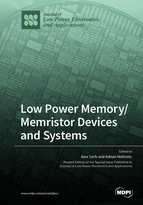Low Power Memory/Memristor Devices and Systems
A special issue of Journal of Low Power Electronics and Applications (ISSN 2079-9268).
Deadline for manuscript submissions: closed (28 February 2022) | Viewed by 47928
Special Issue Editors
Interests: electronic circuits; neuromorphic engineering; computational neuroscience
Interests: functional materials; nanoelectronics; memristors; energy-efficient novel computing paradigms
Special Issues, Collections and Topics in MDPI journals
Special Issue Information
Dear Colleagues,
The continuing proliferation of AI is underpinning an intense interest in hardware development targeting the specific needs of AI computation. Part of the problem lies in the large memory requirements of systems employing millions of weights that are constantly being used to compute outputs. This places an enormous strain on both memory technology, which has to provide cheaper-better-faster memory, and on the Von Neumann architecture, which attempts to solve the problem by squeezing ever more data through an ever tighter pipeline.
The solution to this problem is not simple and encompasses many fields. Over the last few years, it has become clear that one such field is that of emerging memory technologies. By enlisting the help of nanotechnology, engineers are pushing the boundaries of the energy efficiency of memories in a race to the next generation of memory. Much like FLASH memory once upset a world dominated by magnetic memory, these days a multitude of emerging technologies (often collectively referred to as “memristors”) are vying to earn a place in the mainstream memory landscape, promising ultra-low power and area footprints.
This Special Issue will bring together excellent and inspiring work currently being undertaken in the area of low power memory including the following:
- Demonstrations of novel memory devices exhibiting exemplary performance (especially low power operation).
- Novel memory circuits and systems (specifically designed to efficiently incorporate/leverage the benefits of novel nanotechnology).
- Other circuits and systems demonstrating the use of ultra-efficient memory (especially describing what was required in order to successfully implement or incorporate such memory into the system).
Naturally, this list is not exhaustive or exclusive and any contributions that pave the way towards the future of efficient memory are welcome.
We hope that you will contribute your work to this issue and help map the recent progress of memory technology and techniques.
Dr. Alex SerbDr. Adnan Mehonic
Guest Editor
Manuscript Submission Information
Manuscripts should be submitted online at www.mdpi.com by registering and logging in to this website. Once you are registered, click here to go to the submission form. Manuscripts can be submitted until the deadline. All submissions that pass pre-check are peer-reviewed. Accepted papers will be published continuously in the journal (as soon as accepted) and will be listed together on the special issue website. Research articles, review articles as well as short communications are invited. For planned papers, a title and short abstract (about 100 words) can be sent to the Editorial Office for announcement on this website.
Submitted manuscripts should not have been published previously, nor be under consideration for publication elsewhere (except conference proceedings papers). All manuscripts are thoroughly refereed through a single-blind peer-review process. A guide for authors and other relevant information for submission of manuscripts is available on the Instructions for Authors page. Journal of Low Power Electronics and Applications is an international peer-reviewed open access quarterly journal published by MDPI.
Please visit the Instructions for Authors page before submitting a manuscript. The Article Processing Charge (APC) for publication in this open access journal is 1800 CHF (Swiss Francs). Submitted papers should be well formatted and use good English. Authors may use MDPI's English editing service prior to publication or during author revisions.
Keywords
- Low power memory
- Memory circuits
- Memristors
- AI hardware







